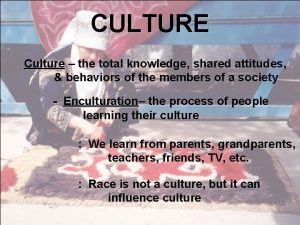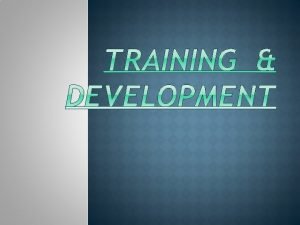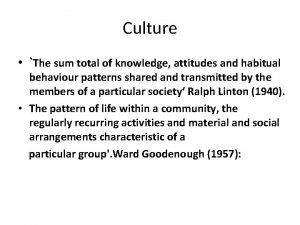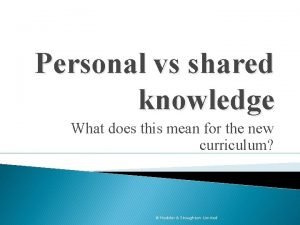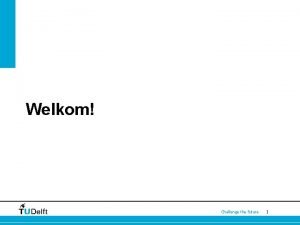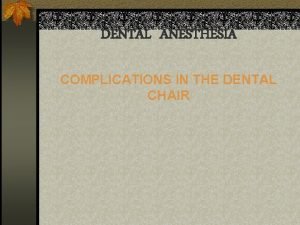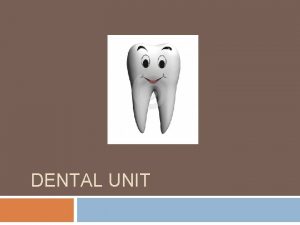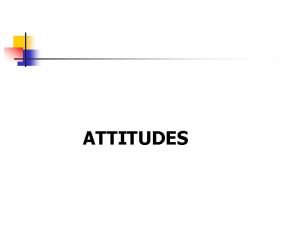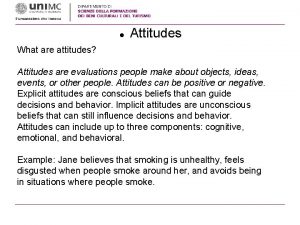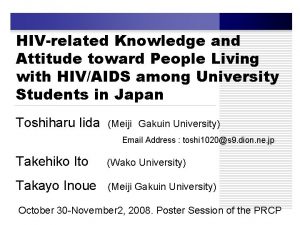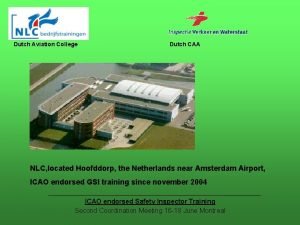Dutch Dental Students HIVrelated attitudes knowledge source of





















- Slides: 21

Dutch Dental Students HIVrelated attitudes, knowledge & source of information AH. Neshat, K. Divaris, R. C. Gorter, Ph. D An EDSA project…

Epidemiological data December 2004 Number of individuals infected Total with HIV/AIDS 39. 4 million (35. 9 – 44. 3 million) New HIV-infections during 2003 AIDS-related deaths during 2003 Adults 37. 2 million (33. 8 – 41. 7 million) Children (<15) 2. 2 million (2. 0 – 2. 6 million) Total 4. 9 million (4. 3 – 6. 4 million) Adults 4. 3 million (3. 7 – 5. 7 million) Children (<15 y. o. ) 640 000 (570 000 – 750 000) Total 3. 1 million (2. 8 – 3. 5 million) Adults 2. 6 million (2. 3 – 2. 9 million) Children (<15) 510 000 (460 000 – 600 000)

Adults and children estimated to be living with HIV as of end 2004 40% 1. 1 million 50% Western & Eastern Europe Central Europe & Central Asia North America 1. 0 million [540 000 – 1. 6 million] Caribbean 440 000 610 000 1. 4 million [480 000 – 760 000] [920 000 – 2. 1 East Asia million] North Africa & Middle East [560 000 – 1. 8 million] 540 000 South & South-East Asia [230 000 – 1. 5 million] Sub-Saharan Africa 7. 1 million Latin America 25. 4 million [4. 4 – 10. 6 million] Oceania [270 000 – 780 000] 1. 7 million [1. 3 – 2. 2 million] [23. 4 – 28. 4 million] Stabilizing 35 000 [25 000 – 48 000] Total: 39. 4 (35. 9 – 44. 3) million

AIDS & Dentistry I. The dentist must be capable of recognizing, documenting & treating oral lesions related to the HIV/AIDS. II. Has the responsibility of referring patients presenting signs & symptoms linked to the HIV infection for further trials. III. Contemporary curricula must entail theoretical and practical training of dental students in treating HIV -related oral lesions. t; n e em t a t 03 IS 0 2 D e: F sembly c r Sou ral As e n e G

Aim To study Dutch Dental students’ HIV/AIDS related attitudes, knowledge, practices and sources of information To investigate possible associations with ‘gender’ and ‘study year’ with the above

Methods Anonymous questionnaire of 56 closed-end questions (yes/no, 4 -point Likert scale) Distributed to all clinical-year present in three University clinics, in Amsterdam, The Hague and Almere Dental School, in December 2003 Data analysis Chi 2 and Wilcoxon tests were performed.

Amsterdam Almere c i n i Cl tions a c o L The Hague

Results N Response 118 questionnaires were returned analyzed Response 3 th year 32 17% 4 th year 52 28% 5 th year 34 18% 118 63% Total Sample description • The sample was consisted of 63 (53. 39%) female and 55 (46. 61%) male students.

Results Supposed routes of transmission of the HIV virus, according to ACTA students

Results Lectures/Seminars & Textbooks Primary Sources

Results TV & School

% 2 1 27, Results Do you believe that the practice of Dentistry entails a high risk of an HIVinfection? % 1 2 Have you ever been injured by a sharp/bloody instrument during your clinical training? Do you think that you follow all necessary infection control measures in the clinics? 87 % 8 , 1 Χ 2 test: p<10 -3

Results Do you consider yourself competent at contributing to an early diagnosis of an HIV-infection? % 28 , 73 NO . 9 NO 0% χ2 test: p<10 -3 Do you believe that if a dentist % as HIV+, they is diagnosed 9 5 , should continue normal 0 7 S practice? YE Do you accept the right of privacy of an HIV+ patient not revealing his situation to you? 83 χ2: test: p<10 -3 If yes, do you believe that 80, it’s their patients’ right to 43 know about his % seropositivity? Y ES

Results I consider my knowledge of the oral manifestati ons of the HIV-infection and their treatment as: 56 % Insufficient/Non-existent Wilcoxon test: p<10 -3

Results I consider my knowledge of the infection control measures necessary in the clinics as: 63 % Sufficient/ Excellent

Results 74 % Wilcoxon test: p<0. 05

Results • 64% of the students answered that they treat all patients as potential carriers of HIV/HBV. • 29% of the 5 th year students stated that they have been injured by a sharp and/or bloody instrument during their clinical training. • 27% of the respondents considered that the practice of dentistry entails high risk of being infected with HIV.

Conclusions No significant variations with regard to ‘gender’ and ‘study year’ were observed Results indicate that the majority of the students retain a positive standpoint towards treating HIV patients More emphasis on certain domains of dental education such as theoretical knowledge of HIV/AIDS oral manifestations and practical training on infection control procedures, may improve dental students’ and thus future dentists’ attitudes and practices towards seropositive patients

Discussion Cross-sectional Time of conduction Generalizability of conclusions Native Language

Questions & Suggestions Houman Neshat Houman@Neshat. net http: //www. neshat. net www. EDSA-net. org …Thank you for your Attention….

 The total knowledge shared attitudes and behaviors
The total knowledge shared attitudes and behaviors New knowledge attitudes and skills acquired in ojt
New knowledge attitudes and skills acquired in ojt Culture is sum of
Culture is sum of Rizal salute to luna and hidalgo
Rizal salute to luna and hidalgo Marzano element 15
Marzano element 15 Marzano element 15
Marzano element 15 Helping students revise knowledge
Helping students revise knowledge Personal and shared knowledge
Personal and shared knowledge Knowledge shared is knowledge squared
Knowledge shared is knowledge squared Knowledge shared is knowledge multiplied
Knowledge shared is knowledge multiplied Knowledge creation and knowledge architecture
Knowledge creation and knowledge architecture Contoh shallow knowledge dan deep knowledge
Contoh shallow knowledge dan deep knowledge Examples of posteriori knowledge
Examples of posteriori knowledge Street knowledge vs book knowledge
Street knowledge vs book knowledge Knowledge and knower
Knowledge and knower Gertler econ
Gertler econ Quran as a source of knowledge
Quran as a source of knowledge Types of secondary brand associations
Types of secondary brand associations Leveraging secondary associations
Leveraging secondary associations Welkom language dutch
Welkom language dutch Interesting facts anne frank
Interesting facts anne frank Why did the dutch republic decline
Why did the dutch republic decline
